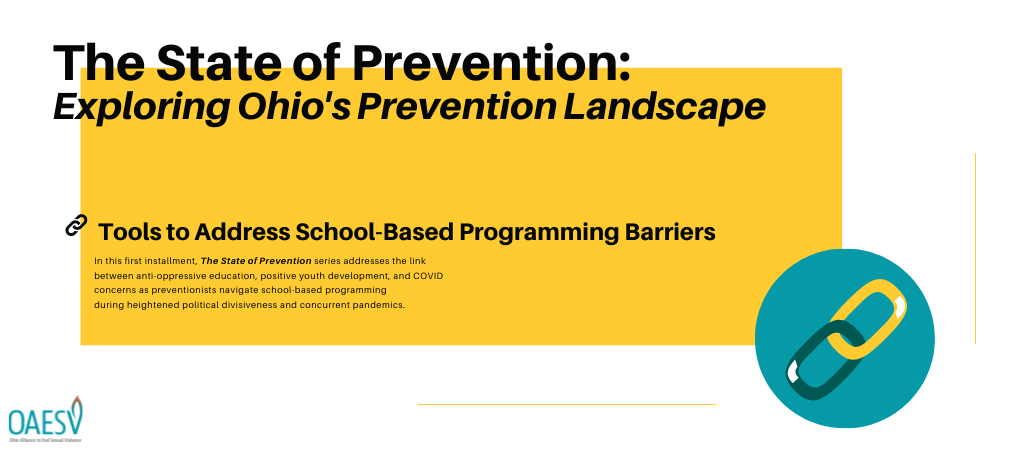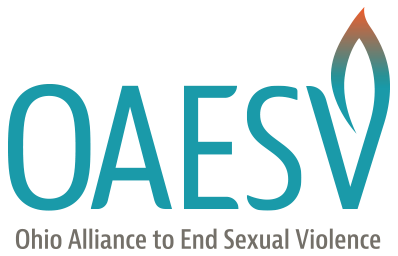
Tools to Address School-Based Programming Barriers
The State of Prevention
Anti-oppression work is primary prevention work. From the beginning of the sexual violence prevention movement, antiracist and abolitionist advocates have led the way forward. Our public health frameworks that connect our relationships, our systems, and our health outcomes are the driving force to prevention at each level—primary, secondary, and tertiary. They identify the intersections of oppressive systems as the driving forces in negative health outcomes. To prevent sexual violence, we must prevent the factors that increase the likelihood of victimization and perpetration.
An imperative tool to minimize risk factors is the early integration of prevention education, which includes understanding ourselves, our relationships, and our systems in order to make empowered decisions in our own lives. Well before curricula are implemented to specifically address sexual violence, students can begin developing self-awareness, self-management, social awareness, relationship skills, and responsible decision-making skills through Social Emotional Learning (SEL) that aid in violence prevention. This “whole child” educational approach has been proven to impact a wide range of lifelong positive outcomes for students, including academic performance, mental wellness, financial stability, favorable self-concept, empathetic relationship maintenance, goal-directed behavior, and more.
For Ohio, SEL implementation is a core foundation of the state’s K-12 education strategic plan Each Child, Our Future, an aspirational guide for student success launched by Ohio’s superintendent of public instruction and the State Board of Education in the summer of 2017. The plan addresses the changing landscape of professional skill sets, increased student body diversity with varying learner needs, and increased early exposure to Adverse Childhood Experiences (ACEs) that can contribute to achievement gaps and lifelong negative health outcomes. To do this, the strategic plan’s first Core Principle is Equity, explaining that, “The path to equity begins with a deep understanding of the history of discrimination and bias and how it has come to impact current society.” The SEL skill development can be more deeply addressed by learning how societal systems historically benefit some and oppress many, often referred to as Critical Race Theory (CRT).
Critical Race Theory has been widely contested throughout the country, stemming from misinformation about its intent and the deep roots of White Supremacy driving historical narratives. Ohioan preventionists, like many K-12 educators, are facing pushback as they attempt to integrate anti-oppressive tenets into education programming. CRT and SEL development are being conflated, without recognition of their complementary components that help to develop resilient, lifelong learners—authentic relationships, caring for one’s community, and empathetic values and beliefs. Preventionists are experiencing external pressure and lack of safety in the classroom in an attempt to navigate the gaps in understanding regarding the intersections of violence prevention, CRT, and SEL.
Additionally, COVID-19 has harshly impacted how young people develop SEL skills. With the lack of social engagement and community connection, students are experiencing decreases in their sense of belonging that stem from isolation, illness, communal uncertainty, and politization of a public health crisis. The pandemic has disproportionately impacted communities of color, which continues to highlight the societal inequities that perpetuate cycles of harm. Concurrently, the US has been forced to reckon with its longstanding public health crisis in response to the state-sanctioned murder of George Floyd in Spring 2020: Racism. These simultaneous and intersecting pandemics have come to a boiling point, and for Ohio, we’ve seen considerable resistance in confronting both COVID-19 and racism.
Preventionists are feeling the weight of this resistance. Prevention education is being scrutinized with claims that the programming is teaching CRT. Classroom facilitators, particularly staff of color, are experiencing lack of safety, and their education intentions are being questioned. Facilitators are providing programming in spaces that do not enforce mask policies, fearful of losing grant funding if they forgo. There is increased hostility and general unrest in classroom spaces due to this ongoing collective trauma. These stressors are undoubtedly impacting the prevention field in Ohio, with a stark increase in preventionist turnover. And those providing direct services in the community are leaving at the highest rates. A critical factor in ending sexual violence is sustainability and continuity of primary prevention, which simply cannot happen if we continue to lose Ohioan experts.
So, what do we do? How do we uphold safety for preventionists, commit to anti-oppressive foundations in prevention education, and cultivate student-centered learning spaces with increased surveillance? Below are some considerations to explore as we move upstream to identify core solutions.
- Implement strategies for ongoing internal organizational support to direct service providers. Considerations include regular team check-ins, legislative landscape updates relevant to prevention, clear protocols for safe program engagement, drafted MOUs to set COVID-19 expectations with community partners, equitable pay for preventionist positions, thorough onboarding processes, safety planning for preventionists in direct service provision, signed exemption slips for classroom learners, and more. Reach out to OAESV for support with these considerations, and learn more about organizational accountability for anti-racism recommendations from the Ohio Anti-Oppression Committee (AOC) here.
- Use shared language as a tool to meet people where they are. Integrating anti-oppressive tenets into prevention education does not have to be named to have impact. Exploring topics of power and privilege in healthy relationships intrinsically intersect with these tenets, while allowing for learners at every level to consider what enduring understandings they will leave the space with. Explore other topics in your programming and how you might present them in a trauma-informed approach with consideration to varied values and beliefs. Pennsylvania Coalition Against Rape created a helpful guide for navigating conversations about SEL and CRT here.
- Stay up-to-date on education recommendations in Ohio and what you are contractually obligated to teach. Ohio’s Each Child, Our Future provides many important talking points for explaining the intersections of SEL and equity through historical understandings of power and oppression. Prepare canned responses for folks questioning the topics being taught with facts from Ohio’s strategic plan and how these lessons fulfill the state’s vision for resilient, lifelong learners. Additionally, talk with your supervisor about what the community partner has agreed to contractually before heading into the classroom.
- Explore your own values and beliefs on SEL, CRT, and their integration with violence prevention education. Clearly communicate the preventionist role in the classroom and in the learner’s development, centering parents and caregivers as their primary educators. Oftentimes when caregivers become weary of educational programming, it’s steeped in concern that the educators are forcing their values and beliefs onto learners. Including a talking point about your role during group agreements can help alleviate that concern, as well as reiterating it throughout the program. To ensure a learner-centered space, we must know what our values and beliefs are in order to identify when we may feel cued by responses that push our boundaries. Supervisors can consider developing a debriefing session with facilitators should they need space to unpack post-program.
- Reach out for support! OAESV provides training, technical assistance, and resources to rape crisis programs, allied organizations, and college campuses, as well as public policy advocacy promoting prevention initiatives and funding. For technical assistance, please contact Caitlin Burke, Director of Prevention, at cburke@oaesv.org.
Primary prevention begins with identifying the roots of the issue and collectively finding sustainable solutions. You are not alone in this journey, and together we will work to end all violence in Ohio. There is strength and power in the collective.
“The State of Prevention” is a blog series that explores Ohio’s prevention landscape, highlighting both history and current events that impact the field.
